If you want to compare the specs of Jackery power stations, you’ve found the right place. This guide is the ultimate comparison chart, quickly showing you the differences between each model.
We’ll start things off with a quick overview of all Jackery options. Then you can use our interactive wizard to choose models to compare. And continue down for a detailed look into the exact specifications for every model.
Are you ready to figure out which Jackery is right for your needs? Let’s do this.
We carefully select the products and services we link to. If you buy through our links, we may earn a commission. There’s no extra cost to you and it helps us provide this information.

Jackery Comparison Chart: Quick Overview
The entire lineup of Jackery products has something for everyone. And in this section, we’ll quickly go over the most important details of Jackery power stations.
This table provides a bird’s-eye view of Jackery’s offerings. Whether you want the smallest and most portable power station or the largest solar generator for home backup power, you can see which Jackery power station fits your needs.
| Product | Battery | Battery (System Max) | AC Output | AC Output (System Max) | AC Input | Solar Input | Warranty | Battery Type | Battery Cycles |
|---|---|---|---|---|---|---|---|---|---|
| Jackery Explorer 5000 Plus | 5,040Wh | 60,480Wh | 7,200W | 14,400W | 4,000W | 5,200W | 5 years | LiFePO4 / LFP | >3,000 |
| Jackery Explorer 3000 Pro | 3,024Wh | 3,024Wh | 3,000W | 3,000W | 1,800W | 1,400W | 3-5 years | NMC | >1,000 |
| Jackery Explorer 2000 Plus | 2,043Wh | 24,516Wh | 3,000W | 6,000W | 1,800W | 1,400W | 3-5 years | LiFePO4 / LFP | >3,000 |
| Jackery Explorer 2000 v2 | 2,042Wh | 2,042Wh | 2,200W | 2,200W | 1,800W | 400W | 3-5 years | LiFePO4 / LFP | >3,000 |
| Jackery Explorer 2000 Pro | 2,160Wh | 2,160Wh | 2,200W | 2,200W | 1,800W | 1,400W | 3-5 years | NMC | >1,000 |
| Jackery Explorer 1000 Plus | 1,265Wh | 5,056Wh | 2,000W | 2,000W | 1,800W | 800W | 3-5 years | LiFePO4 / LFP | >3,000 |
| Jackery Explorer 1000 v2 | 1,070Wh | 1,070Wh | 1,500W | 1,500W | 700W | 400W | 5 years | LiFePO4 / LFP | >3,000 |
| Jackery Explorer 1000 | 1,002Wh | 1,002Wh | 1,000W | 1,000W | 130W | 180W | 2-3 years | NMC | >500 |
| Jackery Explorer 600 Plus | 632Wh | 632Wh | 800W | 800W | 200W | 200W | 3-5 years | LiFePO4 / LFP | >3,000 |
| Jackery Explorer 500 | 518Wh | 518Wh | 500W | 500W | 75W | 90W | 2-3 years | NMC | >500 |
| Jackery Explorer 300 Plus | 288Wh | 288Wh | 300W | 300W | 120W | 100W | 3-5 years | LiFePO4 / LFP | >3,000 |
| Jackery Explorer 240 | 241Wh | 241Wh | 200W | 200W | 90W | 90W | 2-3 years | NMC | >500 |
| Jackery Explorer 100 Plus | 99.2Wh | 99.2Wh | – | – | 100W | 100W | 3-5 years | LiFePO4 / LFP | >2,000 |
Here are some notes about this Jackery chart:
- System Max: These values show the maximum battery and AC output based on using multiple units together in ways that Jackery recommends. It’s possible you may use more creative solutions to use multiple power stations and/or extra battery units in one system, but the System Max values are going to be the most that work together easily in a way that Jackery has designed the units to work.
- Battery: This represents the capacity of the battery, which is provided in Watt-hours (Wh). This value determines how much energy is stored inside of the power station, and therefore, how long it will power your devices. For example, if you want to a 100W device for 10 hours, you need a battery that is at least 1,000Wh (100W x 10h = 1,000Wh).
- AC Output: Most Jackery power stations (except the compact 100 Plus) have standard household 110V/120V outlets on them. These use the AC power inverter that’s built into each power station, and it’s a critical component that converts the battery’s DC energy into the AC power many devices need. This rating is for the maximum energy it can send through the AC outlets at one time. The bigger the number, the more powerful AC devices it can run.
- Solar Input: To use solar panels to charge a power station, you need to be aware of the power station’s specs. These determine the maximum amount of energy the power station can accept at one time. The higher the input watts, the faster the power station will charge. These can also accept other DC charging sources, like the Pecron 500W Car Charger. Never exceed the maximum voltage of the power station.
- Battery Chemistry and Cycles: Despite all using lithium batteries, not all Jackery power stations use the same lithium battery chemistry. The more recently updated ones use LiFePO4 (LFP) battery chemistry, which outlasts the outgoing NMC lithium-ion type. The exact battery life cycles are what Jackery expects for each product to last while still retaining at least 70% to 80% of its rated capacity. The power stations continue to work after this cycle count, but you shouldn’t expect the battery to hold as much of a charge.
- Warranty: Jackery offers a standard warranty period that covers Jackery items purchased through most qualified distributors. But if you want the best warranty coverage, you need to buy it directly from Jackery and register it right away. That is why the warranty period for Jackery power stations has a range in this comparison chart. The lower number applies to most new Jackery items, while the higher number is if you get it straight from the manufacturer.
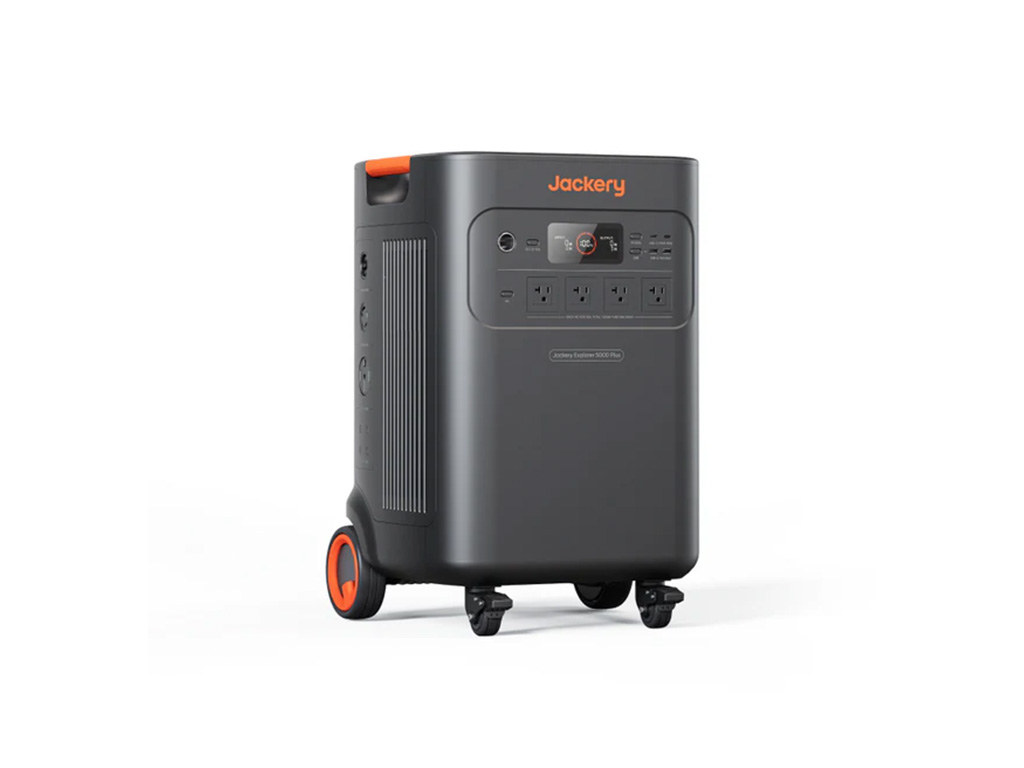
|
Jackery Explorer 5000 Plus |
5000 Plus on Jackery 5000 Plus on Amazon |

|
Jackery Explorer 3000 Pro Portable Power Station |
3000 Pro on Jackery Buy on Amazon |
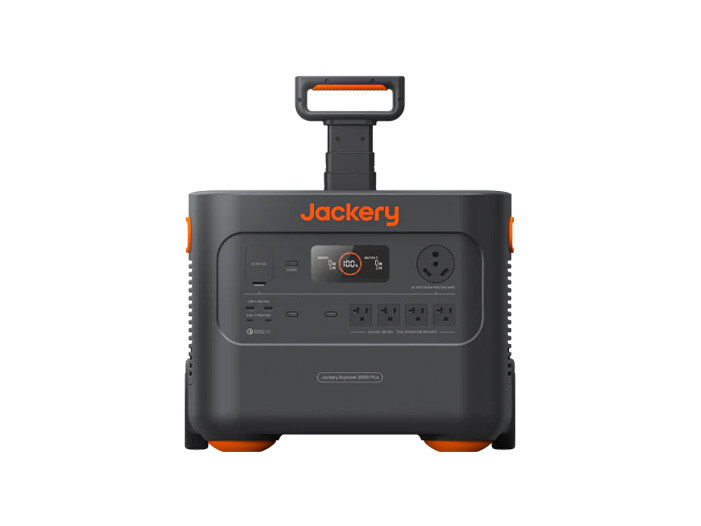
|
Jackery Explorer 2000 Plus Portable Power Station |
2000 Plus on Jackery Buy on Amazon |

|
Jackery Explorer 1000 Plus Portable Power Station |
1000 Plus on Jackery Buy on Amazon |

|
Jackery Explorer 1000 v2 Portable Power Station |
1000 v2 on Jackery Buy on Amazon |

|
Jackery Explorer 300 Plus Portable Power Station |
300 Plus on Jackery Buy on Amazon |
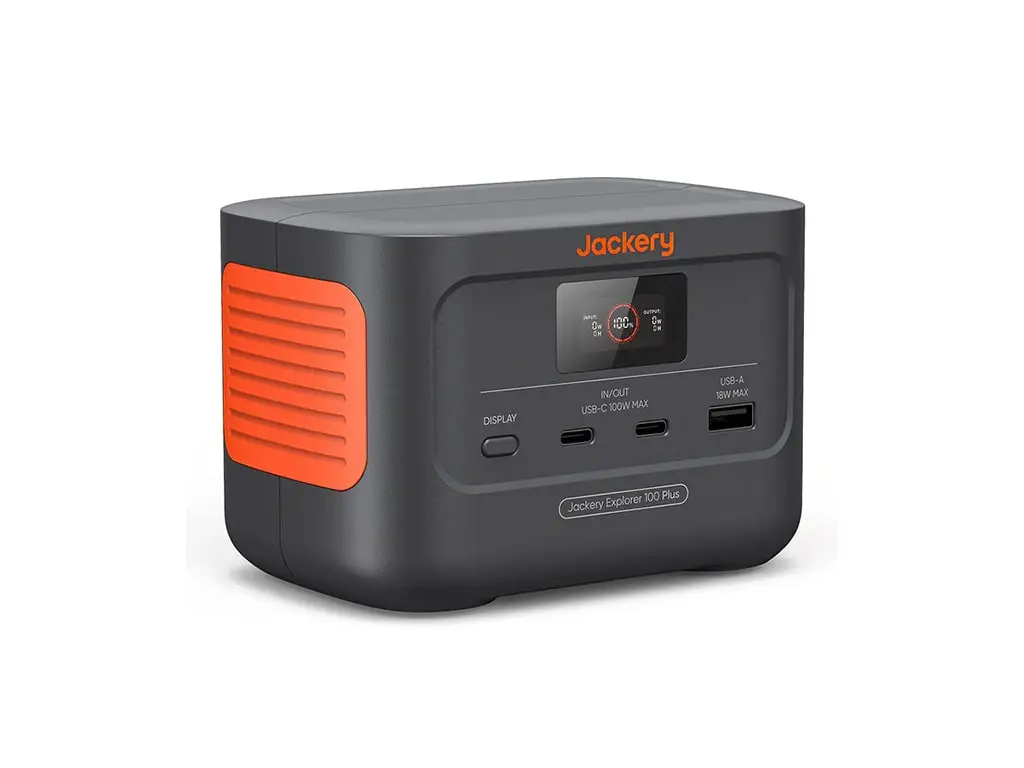
|
Jackery Explorer 100 Plus Portable Power Station |
100 Plus on Jackery Buy on Amazon |
Disclaimer: We work hard to make finding the right Jackery easy for you, but please verify any critical details with the appropriate Jackery documentation. These figures are subject to change and we cannot guarantee their accuracy.
Choose Jackery Product to Compare
Here you can select up to three Jackery power stations to compare. Then select from the drop-down list of specifications that you want to see. After clicking “Show Comparison”, a table will show with the data you want to see.
Select Power Stations
Select up to three power stations to compare:
Jackery Power Station Comparison: Detailed Review
You’ve seen a high-level overview and had the chance to run your own Jackery comparisons. Now it’s time for us to dig deep.
In this part, we’ll walk through each of the different specification groups of the Jackery power stations, helping you understand how these solar generators work. By splitting up these Jackery details into groups, you can carefully consider which power station meets your needs. And understand the differences between Jackery products.
You might want to quickly review our article on How to Understand Power Station Specs before diving deep.
We’ll cover these Jackery comparison charts:
- AC Inverter and Charging
- Solar Charging Details
- Weight and Dimensions
- AC Outlets and DC Ports
- Jackery User Manuals
- All Jackery Specifications
AC Inverter and Charging
Solar power and portable batteries use direct current electricity (DC). But some devices need 110V/120V alternating current electricity (AC). The power station has an AC power inverter and an AC charging input to power these household devices with Jackery power stations.
These AC related details make a big difference in determining what devices you can run and how quickly you can recharge.
| Product | AC Output | AC Output (System Max) | AC Output Peak | AC Input | AC Recharge Hours (Est.) | UPS / EPS |
|---|---|---|---|---|---|---|
| Jackery Explorer 5000 Plus | 7,200W | 14,400W | 14,400W | 4,000W | 1.5h | 0ms / 20ms |
| Jackery Explorer 3000 Pro | 3,000W | 3,000W | 6,000W | 1,800W | 2h | 20ms |
| Jackery Explorer 2000 Plus | 3,000W | 6,000W | 6,000W | 1,800W | 1.4h | 20ms |
| Jackery Explorer 2000 v2 | 2,200W | 2,200W | 4,400W | 1,800W | 1.4h | 20ms |
| Jackery Explorer 2000 Pro | 2,200W | 2,200W | 4,400W | 1,800W | 1.4h | – |
| Jackery Explorer 1000 Plus | 2,000W | 2,000W | 4,000W | 1,800W | 0.8h | 20ms |
| Jackery Explorer 1000 v2 | 1,500W | 1,500W | 3,000W | 700W | 1.8h | 20ms |
| Jackery Explorer 1000 | 1,000W | 1,000W | 2,000W | 130W | 9.2h | – |
| Jackery Explorer 600 Plus | 800W | 800W | 1,600W | 200W | 3.8h | 20ms |
| Jackery Explorer 500 | 500W | 500W | 1,000W | 75W | 8.3h | – |
| Jackery Explorer 300 Plus | 300W | 300W | 600W | 120W | 2.9h | 20ms |
| Jackery Explorer 240 | 200W | 200W | 400W | 90W | 3.2h | – |
| Jackery Explorer 100 Plus | – | – | – | 100W | 1.2h | – |
Here’s some useful information about the AC inverter and recharging rates:
- AC Output: The more watts the AC inverter is rated for, the more powerful devices you can run. For example, a microwave can use around 1,500W or more. Large Jackery units can handle this, but some small Jackery power stations can’t run that high of wattage from the AC outlet. But a WiFi router only uses 30W and basically any AC inverter can power those.
- System Max: This is the maximum AC output when using more than one Jackery power station at the same time. This is based on official Jackery recommendations and may require extra adapters.
- AC Output Peak: When many devices startup, they need a very short surge of power. The AC inverter can supply a peak output higher than its continuous rating to cover those temporary bursts of energy. But you shouldn’t depend on this peak output figure if at possible. You really want to stay under the regular AC Output rating.
- AC Input: The higher the watts of the AC input, the faster the internal battery of the power station will recharge. It’s ideal to have a charging rate that’s fast so you can quickly refill the battery when an outlet is available. For example, if the battery capacity is 1,000Wh and the charging rate is 500W, then it will take a little more than two hours to recharge the battery. Note that recharging speeds can be intentionally slowed down by intelligent software built into the power station to protect the battery, which typically happens when the battery is at 80% capacity or more.
- UPS / EPS: Some Jackery units have a built-in uninterruptible power supply or emergency power supply feature. This means you can keep the power station plugged into a wall outlet on one side, and a critical device on the other (like a WiFi modem/router). Then if the wall power from the utility provide fails during a blackout, the Jackery will quickly switchover to battery power to run the device. This time of ~20ms for the Jackery units means that the output will not provide power for up to 20ms in the event of a blackout. For some devices, this might cause a reboot. It depends on the product. Some UPS devices offer faster switchover times of 10ms or even 0ms (constant), but 20ms is a respectable number for power stations.
Solar Charging Details
One of the best things about portable power stations is the ability to keep them charged with solar panels. You can even use all sorts of third-party solar panels. But you can’t just throw anything at it. You need to know the power station’s specs to ensure that the panels will not harm the power station and that they’ll maximize the recharging rates.
Here are the solar input details for Jackery power stations:
| Product | Solar Input | Solar Recharge Hours (Est.) | Solar Input 1 Watts | Solar Input 1 Volts Min | Solar Input 1 Volts Max | Solar Input 1 Amps | Solar Input 2 Watts | Solar Input 2 Volts Min | Solar Input 2 Volts Max | Solar Input 2 Amps |
|---|---|---|---|---|---|---|---|---|---|---|
| Jackery Explorer 5000 Plus | 5,200W | 1.2h | 4000W | 135V | 450V | 15A | 1200W | 16V | 60V | 21A |
| Jackery Explorer 3000 Pro | 1,400W | 2.6h | 700W | 11V | 60V | 12A | 700W | 11V | 60V | 12A |
| Jackery Explorer 2000 Plus | 1,400W | 1.8h | 700W | 11V | 60V | 12A | 700W | 11V | 60V | 12A |
| Jackery Explorer 2000 v2 | 400W | 6.1h | 200W | 11V | 60V | 12A | 200W | 11V | 60V | 12A |
| Jackery Explorer 2000 Pro | 1,400W | 1.9h | 700W | 11V | 60V | 12A | 700W | 11V | 60V | 12A |
| Jackery Explorer 1000 Plus | 800W | 1.9h | 400W | 12V | 60V | 11A | 400W | 12V | 60V | 11A |
| Jackery Explorer 1000 v2 | 400W | 3.2h | 200W | 12V | 60V | 10.5A | 200W | 12V | 60V | 10.5A |
| Jackery Explorer 1000 | 180W | 6.7h | 180W | 12V | 24V | 7.5A | – | – | – | – |
| Jackery Explorer 600 Plus | 200W | 3.8h | 200W | 11V | 60V | 10.5A | – | – | – | – |
| Jackery Explorer 500 | 90W | 6.9h | 90W | 12V | 30V | 3.75A | – | – | – | – |
| Jackery Explorer 300 Plus | 100W | 3.5h | 100W | 12V | 27V | 5A | – | – | – | – |
| Jackery Explorer 240 | 90W | 3.2h | ~90W | 12V | 30V | 3.75A | – | – | – | – |
| Jackery Explorer 100 Plus | 100W | 1.2h | 100W | 18V | 27.2V | 5A | – | – | – | – |
Here is some crucial information to know about these solar specs:
- Solar Input: This is the most amount of energy the power station will absorb at one time from the solar input. You can also use other ways to generate off-grid energy. The higher the watts, the more panels you can connect and the faster it can recharge the battery. There’s a simple formula to keep in mind to ensure you stay within the specs: watts = volts x amps. For help in figuring out how many panels you need, check out our Solar Panel Calculator.
- System Max: This figure is based on using more than one Jackery power station or extra batteries together in a way that Jackery recommends. This is a great way to get premium performance for large power needs in one connected Jackery system.
- Solar Input 1 & Solar Input 2: Many solar generators have more than one solar input. This means you can connect two entirely separate solar arrays to two different plugs on the power station.
- Input Volts: The MOST IMPORTANT specification is the maximum voltage. You NEVER want to connect solar panels that will exceed the maximum voltage of the input they are plugged into. The Voc of the panels, the number of series connections, and the temperature are some of the factors you need to consider. For more information, check out our article on How Many Solar Panels Can I Use With My Power Station?
- Input Amps: Many experts agree it’s acceptable to slightly go over the maximum current (amps) of the solar input. But anything your solar panels generate over this amount will not be absorbed by the power station. The current is determined by the rating of the panels, the number of parallel connections, and the intensity of the sunlight. The above link to the How Many Solar Panels wizard will help you through this selection as well.
- Adapters: You can use all sorts of solar panels with Jackery products. But you will likely need an adapter. Most Jackery power stations use a specific 8mm plug, while most non-Jackery solar panels use MC4 connectors. A simple MC4 to 8mm adapter makes it so you can use any solar panels with a Jackery solar generator. You’ll also need to understand a little about series and parallel connections for solar panels if you want multiple panels.
Weight and Dimensions
This section is simple. How much does each Jackery weigh? And how big are they? Jackery units can be quite large and heavy, especially the ones ready to power your entire home. But there are also some extremely small and lightweight models, perfect for charging your phone while camping. Here are the details:
| Product | Weight (lbs) | Weight (kg) | Dimensions (in) | Dimensions (mm) |
|---|---|---|---|---|
| Jackery Explorer 5000 Plus | 134.5lbs | 61kg | 16.5×15.5x25in | 418x395x635mm |
| Jackery Explorer 3000 Pro | 63.9lbs | 29kg | 18.6×14.1×14.7in | 473x359x374mm |
| Jackery Explorer 2000 Plus | 61.5lbs | 27.9kg | 18.6×14.1×14.7in | 473x359x374mm |
| Jackery Explorer 2000 v2 | 39.5lbs | 17.9kg | 13.2×10.4×11.5in | 335x264x292mm |
| Jackery Explorer 2000 Pro | 43lbs | 19.5kg | 12.1×10.5×15.1in | 308x269x384mm |
| Jackery Explorer 1000 Plus | 32lbs | 14.5kg | 14×10.2×11.1in | 356x260x283mm |
| Jackery Explorer 1000 v2 | 23.8lbs | 10.8kg | 12.9×8.8×9.7in | 327x224x247mm |
| Jackery Explorer 1000 | 22lbs | 10kg | 13.1×9.2×11.1in | 333x233x283mm |
| Jackery Explorer 600 Plus | 16.1lbs | 7.3kg | 7.8×8.6×11.8in | 197x219x300mm |
| Jackery Explorer 500 | 13.3lbs | 6kg | 11.8×7.6×9.5in | 300x192x242mm |
| Jackery Explorer 300 Plus | 8.27lbs | 3.75kg | 9.1×6.1×6.6in | 230x155x167mm |
| Jackery Explorer 240 | 6.6lbs | 3kg | 9.1×5.2×7.9in | 230x133x200mm |
| Jackery Explorer 100 Plus | 2.13lbs | 0.965kg | 3.4×3.4x5in | 87×86.6x126mm |
AC Outlets and DC Ports
When you are ready to connect devices to the Jackery, you need to know what outlets and ports are available. Some Jackery products have more USB-C ports while others offer a full lineup of AC outlets. Carefully review the available outlets and ports to make sure the Jackery has what you need to power your devices.
| Product | 120V Outlets | 240V Outlets | UPS / EPS | USB-A Ports | USB-C Ports | DC 5521 (Barrel Plug) | Cigarette Lighter | Connectivity |
|---|---|---|---|---|---|---|---|---|
| Jackery Explorer 5000 Plus | 4x20A | 1xL14x30R; 1×14-50 | 0ms / 20ms | 2x18W | 2x100W | – | 1x120W | WiFi / Bluetooth |
| Jackery Explorer 3000 Pro | 4x20A; 1x25A | – | 20ms | 2x18W | 2x100W | – | 1x120W | WiFi / Bluetooth |
| Jackery Explorer 2000 Plus | 4x20A; 1x25A | – | 20ms | 2x18W | 2x100W | – | 1x120W | WiFi / Bluetooth |
| Jackery Explorer 2000 v2 | 3×18.3A | – | 20ms | 1x18W | 1x100W; 1x30W | – | 1x120W | WiFi / Bluetooth |
| Jackery Explorer 2000 Pro | 3×18.3A | – | – | 2x18W | 2x100W | – | 1x120W | WiFi / Bluetooth |
| Jackery Explorer 1000 Plus | 3×16.7A | – | 20ms | 2x18W | 2x100W | – | 1x120W | WiFi / Bluetooth |
| Jackery Explorer 1000 v2 | 3×12.5A | – | 20ms | 1x18W | 1x100W; 1x30W | – | 1x120W | WiFi / Bluetooth |
| Jackery Explorer 1000 | 3×9.09A | – | – | 1x12W; 1×19.5W | 2x18W | – | 1x120W | – |
| Jackery Explorer 600 Plus | 2×6.67A | – | 20ms | 1x18W | 1x100W; 1x30W | – | 1x120W | – |
| Jackery Explorer 500 | 1×4.54A | – | – | 3x12W | – | 2x84W | 1x120W | – |
| Jackery Explorer 300 Plus | 1×2.5A | – | 20ms | 1x15W | 1x100W; 1x15W | – | 1x120W | WiFi / Bluetooth |
| Jackery Explorer 240 | 1×1.82A | – | – | 2x12W | – | – | 1x120W | – |
| Jackery Explorer 100 Plus | – | – | – | 1x18W | 2x100W | – | – | – |
This is one area that Jackery doesn’t quite live up to the competition. For example, Bluetti power stations offer a lot of wireless charging pads which can be a very convenient feature. And some large power stations from brands like EcoFlow and Anker offer powerful 240V outlets. Jackery sticks to the basics, but can get the job done.
Jackery User Manuals
Here are links to all of the Jackery user manuals, which list this information as well as a lot of other useful Jackery tips and advice.
| Product | User Manual |
|---|---|
| Jackery Explorer 5000 Plus | User Manual |
| Jackery Explorer 3000 Pro | User Manual |
| Jackery Explorer 2000 Plus | User Manual |
| Jackery Explorer 2000 v2 | User Manual |
| Jackery Explorer 2000 Pro | User Manual |
| Jackery Explorer 1000 Plus | User Manual |
| Jackery Explorer 1000 v2 | User Manual |
| Jackery Explorer 1000 | User Manual |
| Jackery Explorer 600 Plus | User Manual |
| Jackery Explorer 500 | User Manual |
| Jackery Explorer 300 Plus | User Manual |
| Jackery Explorer 240 | User Manual |
| Jackery Explorer 100 Plus | User Manual |
Images of Jackery Power Stations
Here is a carefully selected list of images for Jackery solar generators and power stations.
Jackery Explorer 5000 Plus
An exceptionally capable Jackery power station with impressive power as a standalone product, and jaw-dropping capacity and power with modular expansion. Can be used with the Jackery Smart Transfer Switch for seamless home power integration.


|
Jackery Explorer 5000 Plus |
5000 Plus on Jackery 5000 Plus on Amazon |

|
Jackery Smart Transfer Switch |
Switch on Jackery |
Jackery Explorer 3000 Pro
A powerful Jackery power station for single unit specs, but lacks modular expansion as found in similar “Plus” models.
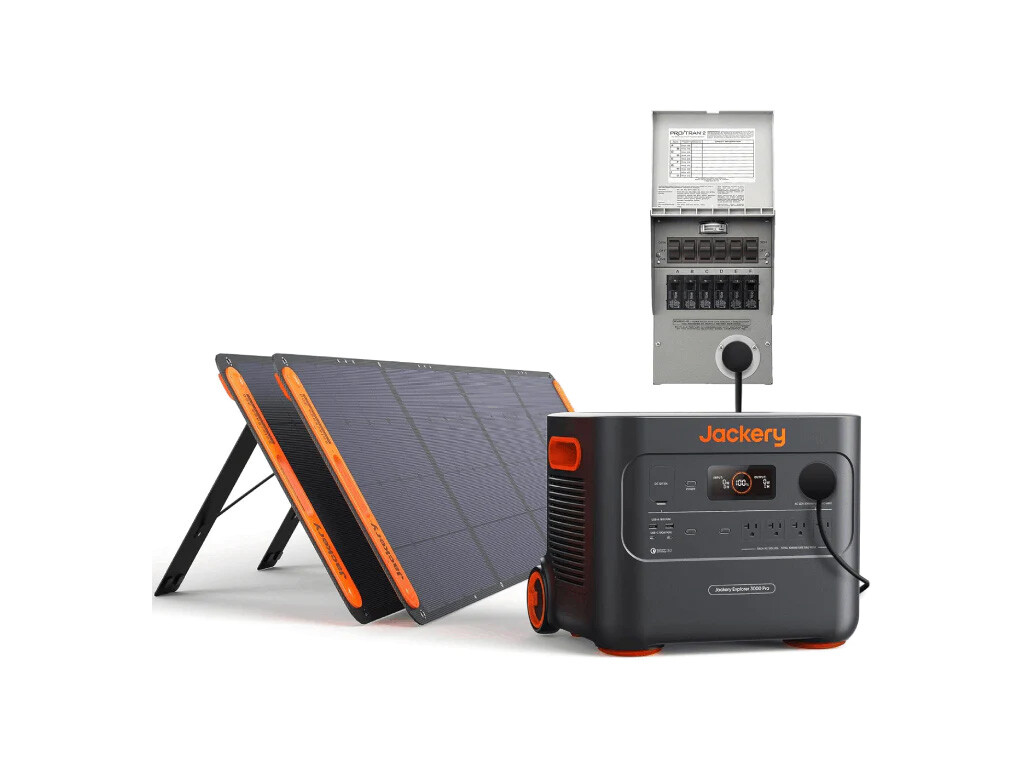

|
Jackery Explorer 3000 Pro Portable Power Station |
3000 Pro on Jackery 3000 Pro on Amazon |

|
Jackery Solar Generator 3000 Pro + 2*200W Solar Panels + Transfer Switch |
Buy on Jackery Buy on Amazon |
Jackery Explorer 2000 Plus
Even though this is not the largest Jackery as a single unit, it can connect with multiple extra batteries and power station units. It’s one of the most powerful Jackery power stations.


|
Jackery Explorer 2000 Plus Portable Power Station |
2000 Plus on Jackery 2000 Plus on Amazon |

|
Jackery Solar Generator 2000 Plus 4kWh + 2*200W Solar Panels + Transfer Switch |
Buy on Jackery Buy on Amazon |
Jackery Explorer 1000 v2
A newly-updated Jackery product that has better battery longevity, faster recharge rates, and the ports that matter most. As far as 1000Wh power stations go, this one is very hard to beat.


|
Jackery Explorer 1000 v2 Portable Power Station |
1000 v2 on Jackery 1000 v2 on Amazon |

|
Jackery Solar Generator 1000 v2 + 1*200W Solar Panels |
Buy on Jackery Buy on Amazon |
Jackery Explorer 600 Plus
As another recent update to the Jackery lineup, the Explorer 600 Plus bring big power in a small package. It’s reaching toward the top of our list of 500W Power Stations.


|
Jackery Explorer 600 Plus Portable Power Station |
600 Plus on Jackery 600 Plus on Amazon |

|
Jackery Solar Generator 600 Plus + 100W Solar Panel |
Buy on Jackery Buy on Amazon |
Jackery Explorer 300 Plus
Even though this is a small Jackery solar generator, this a capable off-grid energy system for small devices. It’s one of the newer Jackery updates and comes with a long warranty to back it up.
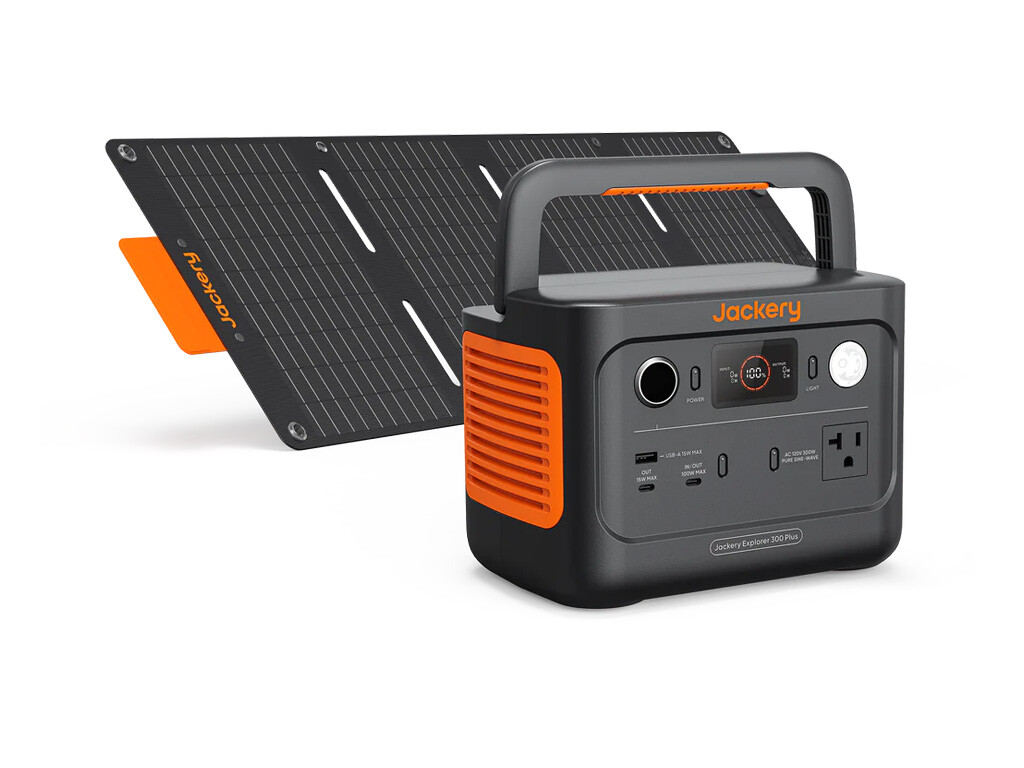

|
Jackery Explorer 300 Plus Portable Power Station |
300 Plus on Jackery 300 Plus on Amazon |

|
Jackery Solar Generator 300 Plus + 1*40W Solar Panel |
Buy on Jackery Buy on Amazon |
Jackery Explorer 100 Plus
When it comes to compact power stations, the Jackery Explorer 100 Plus is the new kid on the block that’s ready for fun. It’s under 100Wh battery means that TSA won’t have a problem with it and you can fly with your Jackery power station. It lacks an AC inverter, but makes up for that with a rock-bottom price and a level of portability other power stations can’t match.
It also comes in a sleek off-white color (as well as the traditional Jackery black).
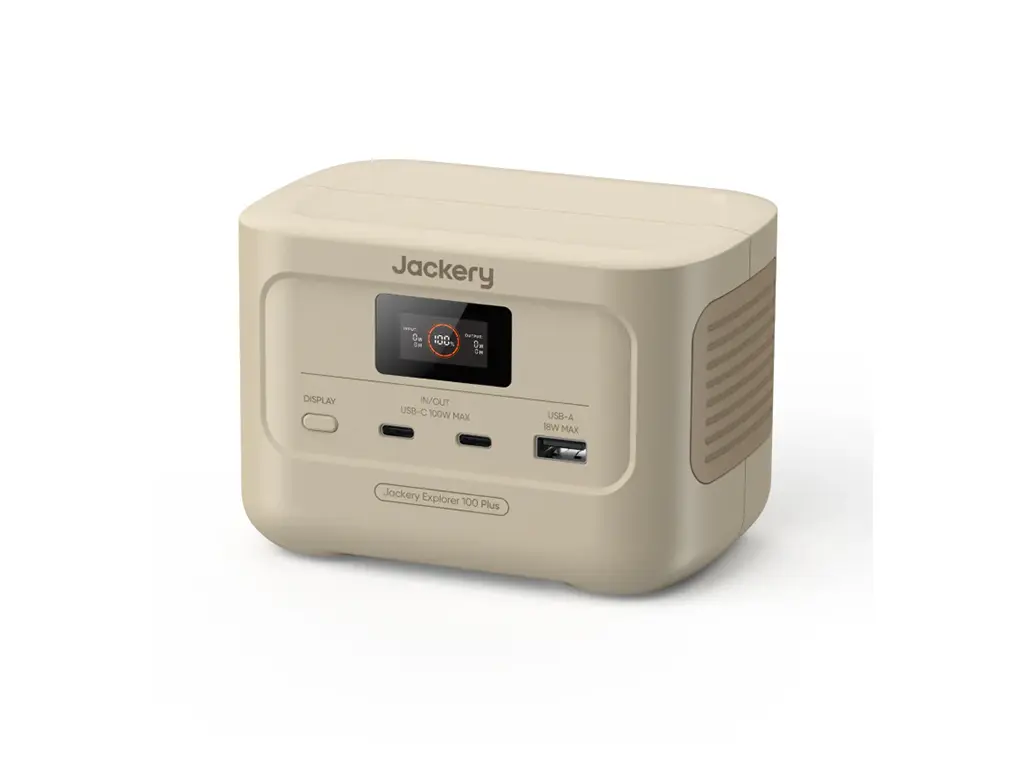

|
Jackery Explorer 100 Plus Portable Power Station |
100 Plus on Jackery 100 Plus on Amazon |
Full Specs Table
And finally, here is a all the specs and links for all power stations in one place.
| Product | Battery | Battery (System Max) | AC Output | AC Output (System Max) | AC Output Peak | AC Input | AC Recharge Hours (Est.) | Solar Input | Solar Recharge Hours (Est.) | Solar Input (System Max) | Warranty | Weight (lbs) | Weight (kg) | Dimensions (in) | Dimensions (mm) | Solar Input 1 Watts | Solar Input 1 Volts Min | Solar Input 1 Volts Max | Solar Input 1 Amps | Solar Input 2 Watts | Solar Input 2 Volts Min | Solar Input 2 Volts Max | Solar Input 2 Amps | Battery Type | Battery Cycles | 120V Outlets | 240V Outlets | UPS / EPS | USB-A Ports | USB-C Ports | DC 5521 (Barrel Plug) | Cigarette Lighter | Connectivity | User Manual | Buy Now | Buy on Amazon |
|---|---|---|---|---|---|---|---|---|---|---|---|---|---|---|---|---|---|---|---|---|---|---|---|---|---|---|---|---|---|---|---|---|---|---|---|---|
| Jackery Explorer 5000 Plus | 5,040Wh | 60,480Wh | 7,200W | 14,400W | 14,400W | 4,000W | 1.5h | 5,200W | 1.2h | 10,400W | 5 years | 134.5lbs | 61kg | 16.5×15.5x25in | 418x395x635mm | 4000W | 135V | 450V | 15A | 1200W | 16V | 60V | 21A | LiFePO4 / LFP | >3,000 | 4x20A | 1xL14x30R; 1×14-50 | 0ms / 20ms | 2x18W | 2x100W | – | 1x120W | WiFi / Bluetooth | User Manual | Buy 5000 Plus | 5000 Plus on Amazon |
| Jackery Explorer 3000 Pro | 3,024Wh | 3,024Wh | 3,000W | 3,000W | 6,000W | 1,800W | 2h | 1,400W | 2.6h | 1,400W | 3-5 years | 63.9lbs | 29kg | 18.6×14.1×14.7in | 473x359x374mm | 700W | 11V | 60V | 12A | 700W | 11V | 60V | 12A | NMC | >1,000 | 4x20A; 1x25A | – | 20ms | 2x18W | 2x100W | – | 1x120W | WiFi / Bluetooth | User Manual | Buy 3000 Pro | 3000 Pro on Amazon |
| Jackery Explorer 2000 Plus | 2,043Wh | 24,516Wh | 3,000W | 6,000W | 6,000W | 1,800W | 1.4h | 1,400W | 1.8h | 17,000W | 3-5 years | 61.5lbs | 27.9kg | 18.6×14.1×14.7in | 473x359x374mm | 700W | 11V | 60V | 12A | 700W | 11V | 60V | 12A | LiFePO4 / LFP | >3,000 | 4x20A; 1x25A | – | 20ms | 2x18W | 2x100W | – | 1x120W | WiFi / Bluetooth | User Manual | Buy 2000 Plus | 2000 Plus on Amazon |
| Jackery Explorer 2000 v2 | 2,042Wh | 2,042Wh | 2,200W | 2,200W | 4,400W | 1,800W | 1.4h | 400W | 6.1h | 400W | 3-5 years | 39.5lbs | 17.9kg | 13.2×10.4×11.5in | 335x264x292mm | 200W | 11V | 60V | 12A | 200W | 11V | 60V | 12A | LiFePO4 / LFP | >3,000 | 3×18.3A | – | 20ms | 1x18W | 1x100W; 1x30W | – | 1x120W | WiFi / Bluetooth | User Manual | Buy 2000 v2 | 2000 v2 on Amazon |
| Jackery Explorer 2000 Pro | 2,160Wh | 2,160Wh | 2,200W | 2,200W | 4,400W | 1,800W | 1.4h | 1,400W | 1.9h | 1,400W | 3-5 years | 43lbs | 19.5kg | 12.1×10.5×15.1in | 308x269x384mm | 700W | 11V | 60V | 12A | 700W | 11V | 60V | 12A | NMC | >1,000 | 3×18.3A | – | – | 2x18W | 2x100W | – | 1x120W | WiFi / Bluetooth | User Manual | Buy 2000 Pro | 2000 Pro on Amazon |
| Jackery Explorer 1000 Plus | 1,265Wh | 5,056Wh | 2,000W | 2,000W | 4,000W | 1,800W | 0.8h | 800W | 1.9h | 800W | 3-5 years | 32lbs | 14.5kg | 14×10.2×11.1in | 356x260x283mm | 400W | 12V | 60V | 11A | 400W | 12V | 60V | 11A | LiFePO4 / LFP | >3,000 | 3×16.7A | – | 20ms | 2x18W | 2x100W | – | 1x120W | WiFi / Bluetooth | User Manual | Buy 1000 Plus | 1000 Plus on Amazon |
| Jackery Explorer 1000 v2 | 1,070Wh | 1,070Wh | 1,500W | 1,500W | 3,000W | 700W | 1.8h | 400W | 3.2h | 400W | 5 years | 23.8lbs | 10.8kg | 12.9×8.8×9.7in | 327x224x247mm | 200W | 12V | 60V | 10.5A | 200W | 12V | 60V | 10.5A | LiFePO4 / LFP | >3,000 | 3×12.5A | – | 20ms | 1x18W | 1x100W; 1x30W | – | 1x120W | WiFi / Bluetooth | User Manual | Buy 1000 v2 | 1000 v2 on Amazon |
| Jackery Explorer 1000 | 1,002Wh | 1,002Wh | 1,000W | 1,000W | 2,000W | 130W | 9.2h | 180W | 6.7h | 180W | 2-3 years | 22lbs | 10kg | 13.1×9.2×11.1in | 333x233x283mm | 180W | 12V | 24V | 7.5A | – | – | – | – | NMC | >500 | 3×9.09A | – | – | 1x12W; 1×19.5W | 2x18W | – | 1x120W | – | User Manual | Buy 1000 | 1000 on Amazon |
| Jackery Explorer 600 Plus | 632Wh | 632Wh | 800W | 800W | 1,600W | 200W | 3.8h | 200W | 3.8h | 200W | 3-5 years | 16.1lbs | 7.3kg | 7.8×8.6×11.8in | 197x219x300mm | 200W | 11V | 60V | 10.5A | – | – | – | – | LiFePO4 / LFP | >3,000 | 2×6.67A | – | 20ms | 1x18W | 1x100W; 1x30W | – | 1x120W | – | User Manual | Buy 600 Plus | 600 Plus on Amazon |
| Jackery Explorer 500 | 518Wh | 518Wh | 500W | 500W | 1,000W | 75W | 8.3h | 90W | 6.9h | 90W | 2-3 years | 13.3lbs | 6kg | 11.8×7.6×9.5in | 300x192x242mm | 90W | 12V | 30V | 3.75A | – | – | – | – | NMC | >500 | 1×4.54A | – | – | 3x12W | – | 2x84W | 1x120W | – | User Manual | Buy 500 | 500 on Amazon |
| Jackery Explorer 300 Plus | 288Wh | 288Wh | 300W | 300W | 600W | 120W | 2.9h | 100W | 3.5h | 100W | 3-5 years | 8.27lbs | 3.75kg | 9.1×6.1×6.6in | 230x155x167mm | 100W | 12V | 27V | 5A | – | – | – | – | LiFePO4 / LFP | >3,000 | 1×2.5A | – | 20ms | 1x15W | 1x100W; 1x15W | – | 1x120W | WiFi / Bluetooth | User Manual | Buy 300 Plus | 300 Plus on Amazon |
| Jackery Explorer 240 | 241Wh | 241Wh | 200W | 200W | 400W | 90W | 3.2h | 90W | 3.2h | ~90W | 2-3 years | 6.6lbs | 3kg | 9.1×5.2×7.9in | 230x133x200mm | ~90W | 12V | 30V | 3.75A | – | – | – | – | NMC | >500 | 1×1.82A | – | – | 2x12W | – | – | 1x120W | – | User Manual | Buy 240 | 240 on Amazon |
| Jackery Explorer 100 Plus | 99.2Wh | 99.2Wh | – | – | – | 100W | 1.2h | 100W | 1.2h | 100W | 3-5 years | 2.13lbs | 0.965kg | 3.4×3.4x5in | 87×86.6x126mm | 100W | 18V | 27.2V | 5A | – | – | – | – | LiFePO4 / LFP | >2,000 | – | – | – | 1x18W | 2x100W | – | – | – | User Manual | Buy 100 Plus | 100 Plus on Amazon |
Wrap Up: Jackery Power Station Specs
The Jackery specs and comparison charts tell a story that any marketing material can’t avoid. By digging into these fine details, this guide has given you everything you need to compare Jackery products and figure out if they meet your needs. Whether you’re concerned about battery chemistry or AC inverter output, you can now make the choice that’s right for yourself.
Didn’t find what you’re looking for? You may want to head over to EcoFlow Comparison Charts.







